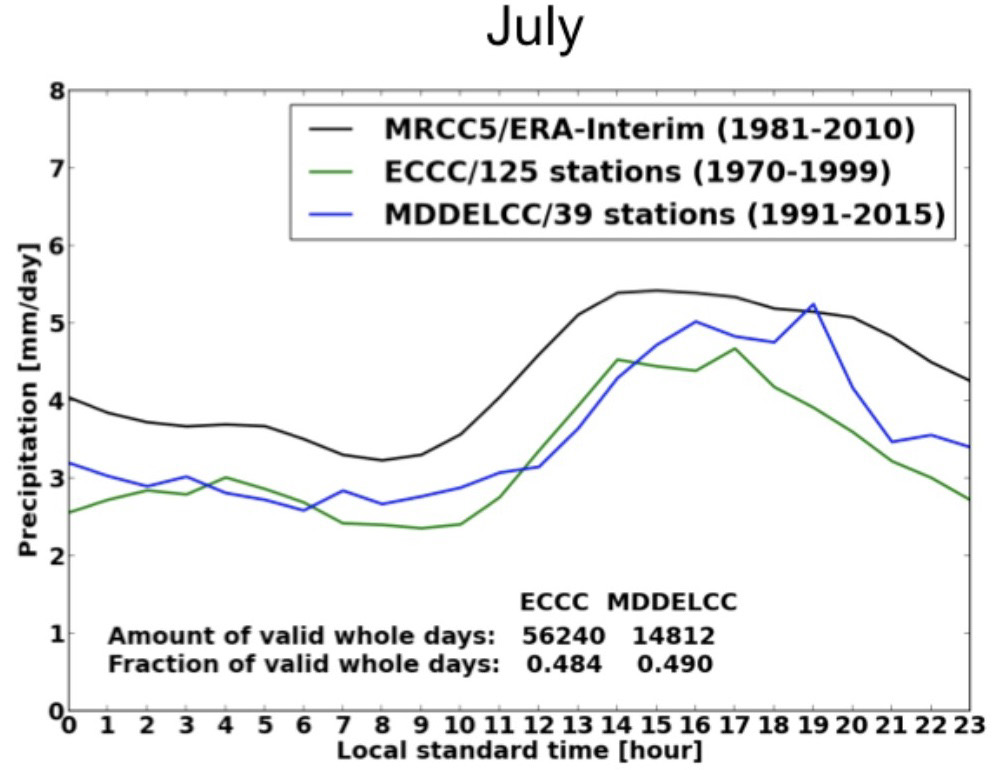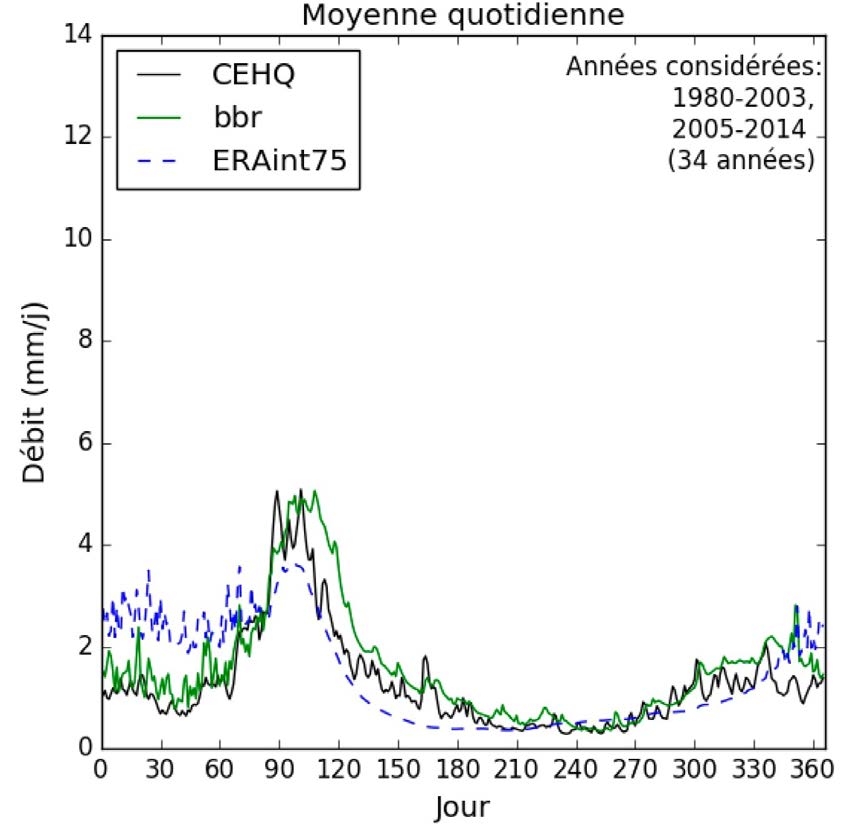Climate reconstruction at Ouranos for Quebec (CROQ)
The "Climate teconstruction at Ouranos for Quebec" CROQ project has created a complete and consistent database for several weather variables of interest to users for recent climate in Québec. For example, CROQ precipitation data is being used for the interpolation of IDF curves in a project with Hydro-Québec, and for post-processing extremes as part of an INFO-Crue project.
Project details
Principal(s) investigator(s)

Context
Weather stations across the Quebec territory are sparse and in operation over varying and often short periods of time. Furthermore, the data they produce contain a limited number of meteorological variables. The incomplete coverage of the territory, both spatially and temporally, makes it difficult to produce an accurate picture of the Quebec climate and its meteorological history. This difficulty is particularly pronounced for users who need variables other than temperature and precipitation as well as for those interested in Quebec’s northern territory, where monitoring stations are few and located almost exclusively along the coast.
Objective(s)
-
Produce, using the new version of the Canadian Regional Climate Model (CRCM5), a comprehensive climatology of Quebec in order to provide the best possible approximation of the weather conditions of the last 30 to 40 years.
-
Update available data based on the evolution and the development of the CRCM5 and on new opportunities for performing simulations (e.g., availability of new driving data).
Methodology
-
Use of the latest version of the CRCM5 to produce the climatology of the recent climate of Quebec, allowing for a more refined spatial resolution of the reanalyses.
-
Meetings with users to define their needs and expectations in this project.
-
Updating of the database based on the evolution of the CRCM and the driving data available in each phase.
Results
A set of four CRCM5 simulations at a resolution of 12 km, driven by ERA-Interim reanalysis over the 1979-2014 period, were produced and analyzed under the project. This set of simulations made it possible to quantify the effects of internal variability and selected CRCM5 configuration choices on the results. Several validations of the simulated data were carried out to assess their ability to reproduce long sequences of weather conditions throughout Québec for recent climate.
Based on series of seasonal averages, various analyses were used to validate climate averages, interannual standard deviation and interannual correlation for daily minimum and maximum surface temperatures and precipitation simulated by CROQ. These variables, which are indispensable for many users, are also those with the most varied and the most reliable sources of observation. The results (Takhsha 2017, internship report) showed that the CROQ data successfully reproduce the general patterns and amplitudes of the climate averages of these variables. In addition, thanks to the high resolution of CROQ, local effects from the presence of lakes or mountains are simulated reasonably well. However, it can be seen that CROQ surface temperatures are generally too cool, especially in northern Québec, a bias that is more pronounced for daily minimums. There is also a tendency for CROQ to produce too much precipitation (wet bias). For the other statistics (variability and correlation) the results are generally lost in the significant disparities found between the different sources of observation.
Validation analyses of the diurnal precipitation cycle (Fang 2016, internship report, see Fig. 1) and various indices related to extreme precipitation were also carried out. In both cases, the results were generally satisfactory. Validation results for other variables such as freezing rain (Bresson et al. 2017), snow cover (Bresson 2019) and long and short radiation show that CROQ simulations for these variables are comparable to available observations. Finally, to meet targeted hydrology needs, a validation of CROQ runoff was conducted (Flansberry 2018, internship report) in addition to testing the use of CROQ data as inputs to various hydrological models.

Figure 1 : Mean diurnal precipitation cycle for the month of July in southern Québec for different climate periods. The cycles come from CROQ simulation (black), 125 ECCC stations (green) and 39 MDDELCC stations (blue). This figure, taken from the Fang internship report (2016), shows that CROQ successfully reproduces the July diurnal cycle despite an overall wet bias.

Figure 2 : Average annual runoff cycle for the Châteauguay River basin. The cycles come from a CROQ simulation (green), DEH observations (black) and ERA-Interim reanalysis (blue). In this figure, taken from the Flansberry internship report (2018), CROQ is seen to successfully reproduce the annual runoff cycle, although with a spring peak that occurs a few days late.
In conclusion, various simulated meteorological variables from the CROQ database were validated in various studies. In general, the results suggest that this database is comparable to several observation-related sources (gridded observational data, reanalysis, etc.).
On the other hand, several results show that the data simulated by CROQ have a systematic bias towards excess precipitation. With regard to uncertainty quantification, we generally find that, with few exceptions, the results of the CROQ simulations are minimally affected by internal variability or CRCM5 configuration choices.several observation-related sources (gridded observational data, reanalysis, etc.).
Benefits for adaptation
Benefits for adaptation
The CROQ project has created a complete and consistent database for several weather variables of interest to users for recent climate in Québec. For example, CROQ precipitation data is being used for the interpolation of IDF curves in a project with Hydro-Québec, and for post-processing extremes as part of an INFO-Crue project.
Scientific publications
Funding
Ce projet est financé par le gouvernement du Québec et répond aux objectifs du Plan pour une économie verte 2030.



Other participants
-
Université de Québec à Montréal (UQAM) / Centre pour l'Étude et la Simulation du Climat à l'Échelle Régionale (ESCER)
-
Environnement et Changement climatique Canada / Climate Processes Section
-
Ministère de l'Environnement et Lutte contre les Changements Climatiques (MELCC)